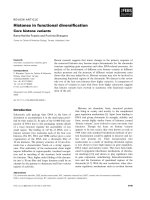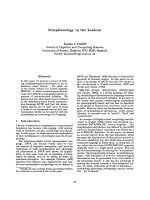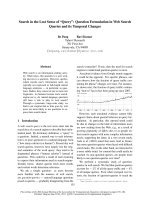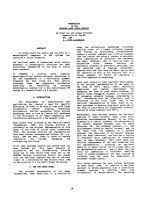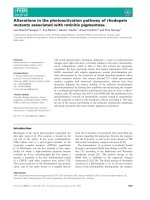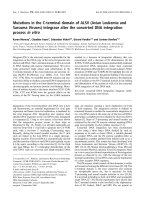Báo cáo khoa học: "MORPHOLOGY in the EUROTRA BASE LEVEL CONCEPT " pdf
Bạn đang xem bản rút gọn của tài liệu. Xem và tải ngay bản đầy đủ của tài liệu tại đây (520.21 KB, 7 trang )
MORPHOLOGY
in the
EUROTRA BASE LEVEL CONCEPT
by Peter Lau and Sergei Perschke
Commission of the EC,
Bat.
JMO
L - 2920 Luxembourg
ABSTRACT
Xn recent years the nature and the role of a
morphological component in NLP systems has
attracted a lot of attention.
The two-level model of Koskenniemi which relates
graphemlc to morphological structure has been
succesfully implemented in the form of finite
state automata.
Xn EUROTRA a solution which combines
morphological and surface syntactic processing in
one CFG implemented in a unification grammar
framework has been tried out. This article
contrasts these
two
approaches considering
especially the feasibility of building
morphologlcal modules for a big multilingual MT
system in a decentralised R & V project.
O. INTRODUCTION
The development of sophisticated NLP
applications has created a need
for
specific
processing in order to be able to cope with large
vocabularies without creating monstruous
dictionaries. Earlier approaches often avoided
morphology more or less by listing full wordforms
in the dictionary or by simply segmenting some
inflectional endings with a few general rules.
Much recent work is based on the Two-level Model
(Koskenniemi, 1983) and relates directly or
indirectly to the original implementation of this
model in the form of finite state transducers
(FST). The original notation and implementation
have been further developed and refined (cf. e.g.
Black, 1986 and Bear, 1986) in order to improve
compilation and runtime, debugging and
rule-writing facilities.
Still some problems persist and others have not
been touched yet. This paper presents an
alternative, but not contradictory, solution
which has to some extent been tried out in the
EUROTRA Machine Translation Project and argues
that the two-level approach may not be entirely
viable in a decentralised R&D project which aims
at ~he creation of a big multilingual HT system.
I. THE TWO-LEVEL
MODEL
The original presentation of the model
(Koskenniemi, 1983) shows that it is possible to
treat the inflectional morphology (including
spelling rules) of a highly inflected language
like Finnish by establishing correspondences
between a surface alphabet and a lexical alphabet
(the two levels) and using a lexicon to determine
which combinations of characters and morphemes
are legal. Moreover, this is
done
by means of
declarative rules, thereby avoiding the
procedural problems of generative phonology, and
the algorithm used is language independent.
Together with the fact that the model may bc used
for synthesis as well as for analysis this is a
strong argument in favour of employing a
two-level approach to morphology.
Later work points to some important shortcomings
of the original implementation of the model in
the loom of FST's (Black, 1986). Especially
compilation and runtime requirements and
debugging are seen to pose severe problems. In
Black's words:"Debugging automata is reminiscent
of debugging assembly language progranuuing in
hex". Considering that the (linguistic) user is
interested in the rules rather than in the
low-level implementation of them, Black et al.
have proceeded to develop high-level notations in
the form of rules which are interpreted directly,
instead of being compiled into FST's.
Nonetheless, they entirely respect the two-level
approach in their notation. Their rules still
establish correspondences between,
on one
side,
elements of a lexical alphabet (the characters of
the natural language alphabet plus the empty
character (if), the morpheme boundary (+), and
archiphonemes (noted as capital letters)) and, on
the other side, the elements of a surface
alphabet
(the
characters of
the
natural language
plus the empty character), and they use a lexicon
to determine which combinations of characters
make up legal morphemes. Their work shows the
relative independence of the rule formalism from
its implementation - accepting the two-level
model by no means forces one to accept FST's as
an implementation vehicle - and it shows that the
rules for combination of characters (spelling
rules or morpho-graphemics) are best treated in
isolation from the rules for combination of
morphemes (morpho-syntax).
This latter approach has been further developed
by Bear (Bear, 1986). He combines a two-level
approach to morpho-graphemics with a unification
grammar approach (a modified PATE rule
interpreter) to morpho-syntax. The resulting
19
implementation preserves the generality and
flexibility of the treatment of morpho-graphemic
phenomena like allomorphy while, at the same
time, avoiding the problems of treating
morpho-syntax in the lexicon, which in reality is
what happens in Koskenniemi's original model
where the lexical entries for root morphemes are
marked for "continuation classes" (references
to
sub-lexicons which determine the legal
combinations of morphemes).
Furthermore,
by treating morpho-syntax in a
unification grammar
framework,
Bear obtains an
effect which is very important provided that
morphological analysis and synthesis are normally
regarded as elements or modules of systems which
also do other kinds of language processing, e.g.
syntactic parsing: He reaches a stage where the
output of the morphological analyser is something
which can easily be used by a parsee or some
other program (Bear, 1986, p. 275).
Still, one must admit that only subsets of
morphology have been treated within the two-level
framework and its successors. Most of the work
seems to have centred on inflectional morphology
with a few excursions into derivation and a total
exclusion
of
compounding which is a very
important phenomenon in languages like German,
Dutch and Danish. It is also noteworthy that none
of the implementations mentioned above could be
used for the analysis (or synthesis) of running
text because they know no capital letters, no
numbers, no punctuation marks or special
characters, nor formatting information. This does
not mean that such things could not be taken care
of in combination with a two-level framework (for
instance by a pre-processor of some kind), it
just means that in order to cater for them one
needs new kinds of notations and implementations
(as numbers could hardly be analysed as lexicon
entries) with the corresponding interfacing
problems (cf. Bear's motivation for using a
unification grammar for morpho-syntax).
IT. THE EUROTRA BASE LEVEL
I. BackKround
EUROTRA is a decentralised R & D project
aiming at the development of a multilinEual
machine translation system. Thus, on top of the
classical
coder
consistency problems known from
the development of big )ST systems like SYSTRAN,
EUROTRA has to ensure consistency of work done in
some 20 geographically dispersed sites. This
calls for a strong, coherent, understandable,
problem oriented and comprehensive framework.
Considering also that the software development in
the project is supposed to be based on rapid
prototyping, it becomes clear that the project
has to build on some general idea about how
things will fit together in the end. We cannot
afford to build independent modules (e.g. an FST
implementation of a morphological component, a
PATR-II grammar for our syntactic component
implemented in PROLOG, some SNOBOL programming
for the treatment of text formatting, special
characters etc, and a relational database for our
dictionaries) and then start caring about the
compatibility of these modules afterwards.
Consequently, the EUROTRA base level which treats
all kinds of characters (alpha-numeric, special,
control etc.) and morphemes and words has been
conceived as a part of the general EUROTRA
framework and described in the same notation as
the syntactic and semantic components.
In the absence of a dedicated user language
(which is bein E developed now) the EUROTRA
notation is the language of the virtual EUROTRA
machine. This virtual machine stipulates a
series
Of so-called generators (G's) linked by sets of
translation rules (t-rules). Each generator
builds a representation of the source text (in
analysis) or the target text (in synthesis) and
it is the job of the linguists who are building
the translation system to use these generators in
such a way that they construct linguistically
relevant levels of representation (e.g.
morphological, syntactic constituent, syntatic
relation and semantic representations). The
individual generators are unification grammars
consisting of
constructors
which
are
basically
functions with a fixed number of arguments and
atoms which are constructors with no arguments.
An
atom has
the
form
(name,~feature
description~)
The feature description is a set of
attribute-value pairs (features) with one
distinguished feature, called the name, which is
caracteristic for each generator (e.g., for the
surface syntactic generator it would be syntactic
category). The name is placed outside the curly
brackets, and only the value is given.
A constructor has the form
HEAD ARGUMENTS
where
the
n=name and fd=feature description. In
functional terms this represents a function
(described by the head) over n arguments.
The t-rules relate the representation built by a
generator to the atoms and constructors of the
subsequent G,
thereby
making it possible for this
G to build a new representation of the
translation of the elements of the preceding one
in a compositional way (cf. EUROTRA literature
(2,3 and 4) in the reference list).
The virtual machine has been implemented in
PROLOG and an Early-type parser has been used to
build the first representation in analysis
(viewed as a
tree-structure
over the input
strins). This implementation, of course,
20
represents a choice.
Other
programming languages
and parsers might have been used. The system
implemented by Bear, e.g. indicates that a
two-level approach to morpho-graphemica may be
combined with a unification granuuar approach to
morpho-syntax. For various reasons, though we
have not chosen this solution.
2. Text structure and lexico~raphic
consistency
The first serious problems encountered in
choosing a two-level approach to morphology in an
MT system is the question of what to do with all
those characters which are not letters. If we
find a piece of text like
A. This question will be discussed with the
Director General on April 25th.
we do not want an analysis which tells us that
the system has found 4 nouns (one being a
'proper'
noun), 3
verbs
(one
finite,
two
infinites), two determiners, two prepositions and
some unintelligible elements which another
machine will have to take care of. We want to
know that "Director General" is a compound which,
syntactically, behaves like a single noun, that
"April 25th" is a date (because it may be a
time-modifier of a sentence), that "A" is an
index which indicates some enumerative structure
of the text, that "." is a punctuation mark which
may indicate that a sentence ends here, and
probably more information which we need if we
want to build a representation of the whole text
and not just of some selected words or simple
sentences.
It seems difficult to see how the two-level
approach could cope with compounds, apart from
entering them all into the lexicon, and this
would really he a heavy burden on the lexicon of
compounding languages. Single letters llke "A."
and even punctuation marks might be included in
the lexicon, but numbers could not for obvious
reasons.
Furthermore, control and escape sequences which
determine most of the text structure (font,
division
into
chapters, sections, paragraphs
etc.) in any editor or word processor might be
entered into the lexicon, but the two-level
approach does not provide any solution to the
problem
of
giving these sequences an
interpretation which is useful in building a
representation of the text structure.
In order to cope with these problems, we have
chosen, in EUROTRA, to define the input and the
output of the system as extended ASCII files. The
ASCII characters, including numbers, special and
control characters, are defined as the atoms of
the first level of representation and thereby
provided with an interpretation which makes it
possible for them to serve as arguments of
constructors which build a tree-structure
representing the text and all its elements, also
those elements which are not words.
The second problem in the two-level approach is
that, apart from the fact that some textual
elements seem to be totally outside the scope of
the lexicon, even those elements which go into
the lexicon pose a series of problems in our
context.
For MT to be of any use and efficiency we need
large dictionaries which cover a substantial part
of the vocabularies of those languages treated by
the MT system. It is known from a lot of MT
systems that the coding of large dictionaries (or
lexica) cannot be left to a small group of people
working together in close contact for a limited
period of time. Many coders working over long
periods are needed, and they will constantly be
maintaining, revising and up-dating the work of
one another. For such an enterprise to succeed
one needs extremely strong and detailed
guidelines for coding, and the coding language
should be as simple and transparent as possible
and contain no contentious elements from a
theoretical point of view. Morpheme boundaries,
archiphonemes and null-characters are hardly
uncontentious in the sense that, e.g. everybody
agrees on the root form to employ in 'reduction'
('reduce' or 'reduc' ?), and even the slightest
disagreement will invariably jeopardize the
intercoder consistency which is absolutely
necessary for an MT project to succeed.
3. Character normalization and morpheme
identification
The atoms of the base level identify and
interpret the characters of the input file in
that the name of the atom unifies with the input
character (for non-prlntable characters
hexadecimal notation in quotes is used):
( A, { type = letter, subtype = vowel, char=a,
case = upper~)
( k, ~ type = letter, subtype = vowel, char=a,
case lower, accent = grave~)
('IB', ~type = control_char, subtype = escape~ )
In a unification granuuar which allows the use of
named and anonymous variables, it is easy to join
all variants of the letter 'a' under one heading
(a constructor in EUROTRA terms) and percolate
all relevant features to this beading by means of
feature-passing. This is called normalisatlon in
our tet~us, and it simply means that all
typographical variants of a character are
collapsed so that the dictionary will only have
to contain one character type. A normalizing
constructor for 'a t could be:
21
(a, ~type = letter, subtype = vowel, case = X,
accent = Y~)
('?, ~char = a, case = X, accent = Y})~
where '?' is the anonymous variable. The argument
of this constructor will unify with any atom
containing the feature 'char = a' and accept the
values for 'case' and 'accent' found in these
atoms. By feature-passing these values will then
be percolated to the head.
At this stage the representation of the input
file is a sequence of normalised characters. This
sequence is now matched against the dictionary or
lexicon which is Just another set of constructors
of the form
(for, ~ class = basic_word, type = lexical,
cat = prep, paradigm = invariant })
I
f, O,
r~
(for, ~ class = basic word, type = prefix,
paradigm = derivation ~ )
I
f, o , rJ
Matching here means the kind of matching which
occurs in unification. This means, of course,
that the overgeneration may be severe in some
case, e.g. each of the 's' appearing in
Mississippi will i.a. be interpreted as a plural
morpheme. This overgeneration must be
constrained. We are working with this problem and
some results are ready, which confirm that our
approach to character normalisation and
dictionary look-up, i.e. the one described above,
provides for a straight-forward, strict and yet
perfectly understandable and uncontroversial
coding of dictionary entries. The set of possible
features and the co-occurrrence constraints
holding between those features are defined in
advance. What the dictionary coder has to do is
to choose the relevant features for each lexical
item (basic word in our terminology) and write
them into the relevant constructor which will
operate in total independence of any other
constructor. There will be no problems with
linking sub-lexicons or discussing morpheme
boundaries, because each constructor operates
directly on the sequence of surface characters,
i.e. the problem of whether the surface form of
'ability' is a b i 1 ~'i t y or
a b i 1 ~ ~ i t y does not exist (cf. Black
1986, p. 16). The ensuing problems in relation to
the treatment of allomorphy are exposed below.
4. Implementation
The EUROTRA Base Level has been implemented
by means of a prototype version of the virtual
machine implemented in PEOLOG with an Early-type
parser. This prototype was constructed in such a
way that the parser would only work in one of the
generators, i.e. the first generator employed in
analysis, while the other generators would
produce transforms of the tree-structure built by
the first generator.
Due to this constraint, we had to collapse
morpho-syntax and surface syntax into one
generator which built a tree over the sequence of
characters of the input file via normalized
characters, basic words, complex words
(inflected, derived and compound wordforms),
phrasal nodes (NP, VP, PP etc.) and ending at an
S top node. The resulting grannnars became very
big, and testing in most cases had to be done
with sub-grammars in order to prevent loading and
parsing times from becoming prohibitive.
Actual implementation work was done in 5
languages (English, German, Dutch, Danish and
Greek), and several sub-grammars were
successfully implemented and tested. The most
important experience was that the different
groups participating in the project were able to
understand the base level specifications and to
use them or deviate from them in a principled way
producing comparable results.
The prototype used for this first implementation,
however, was a fairly unelegant and
user-unfriendly machine which was rather intended
to be running specifications than a vehicle of
constructing and testing granuuars. With a more
streamlined prototype two constraints on
implementation and testing of grammars would be
relieved: loading and runtime requirements would
diminish radically and it should be possible to
use parsing or parsing-like procedures in more
than one generator.
This would allow us to construct a full MT system
with a standardised and simple dictionary format
and capable of treating all kinds of characters
which may appear in an input file.
5. The
base levels
The linguistic specifications of this
system, which is to be implemented in the present
phase of the project, have been elaborated in
some detail. The input to the system will be
files containing characters in a 7 or,
preferably, 8 bit code (in order to cover the
multilingual EOROTRA environment). The characters
unify with atoms of the type described above. The
atoms then unify
with
abstract wordform,
sentence, paragraph etc. constructors of the
following kind:
22
(wordform) /~+(?, {type = letter} )~
(sentence)
[
+ wordform, (?,
~type = punctuation_mark~ )1
(paragraph)
[ +
sentenc_e, (fin paragraph,
•
~char ffi double CR} )
where ? is still the anonymous variable, '+' is
the Kleene plus signifying one or more of the
following argument and 'double carriage return'
is assumed to be the character (or sequence)
indicating termination of a paragraph in the text.
These abstract constructors will build a
tree-structure representing the full input text
from the characters via the words, the sentences,
the paragraphs, the sections etc. to a top T(ext)
node, of course with some overgeneration, e.g.
some punctuation marks do not terminate a
sentence, but the overgeneration will be filtered
out by subsequent generators using morphological,
syntactic and semantic
information.
The generator following the first (text
structure) level will normalise the characters by
a many-to-one mapping of, e.g. variants of 'a',
and all the basic words of the system component
(e.g. the English analysis component), i.e. the
major part of the monolingual dictionary, will be
present
in
this generator in the form of
constructors (cf. the 'for' constructor mentioned
above). This will cause some overgeneration as
illustrated
above
with the
example 'Mississippi'
but an abstract wordform constructor which is
connected by a t-rule to the representations
built by the abstract wordform constructor of the
previous (text structure) level will filter out
spurious results:
(wordform) ~ +(?, [class = basic_word~)~
Given that 'mi', 'i' and 'ippi' are not all basic
words of English, no interpretation of the 's' as
plural or third person singular markers will be
allowed, because each wordform has to cover
exactly one sequence of basic words exhaustively
without overlapping.
Assuming that 'Mississippi' is a basic word of
English present in the dictionary (as a
constructor of this level), the sequence of
normalised characters 'mississippi' will receive
at least one legal interpretation which is then
translated into the subsequent (morpho-syntactlc)
level by a t-rule.
The treatment of allomorphic variation in this
approach will rely on alternating arguments in
the basic word constructors. In order to cover
the alternation y - ie found in, e.g., city ~
cities' we shall have to use a basic word
constructor of the following form:
(city, ~ ~) ~c, i, t, (i;y)]
where ';' is the alternation operator. This
constructor will unify with any of the two
sequences 'citi' and 'city', and if we create two
basic word constructors over the plural ending of
nouns (covering at the same time the third person
singular of the present tense of verbs), i.e. (s)
and (es), e.g.
we may cover the wordform 'cities' by (citi) and
(es). A definite advantage of using this approach
is that it covers allomorphic variation inside
the root form like in German plural of nouns:
Mann > M~nner
by (mann,{ ~)Ira, (a, ~), n, nJ
The only way of covering this phenomenon in the
two-level approach seems to be by entering both
'Mann' and 'M~nn' into the dictionary as possible
roots.
The generator following the level where basic
word identification takes place contains, as its
atoms, the basic words translated by t-rules from
the representations built
by
the basic word
constructors. The characters, which are the atoms
of the previous level, are cut off by receiving a
0 translation.
The constructors of this generator are wordform
(or complex word) constructors covering the
various
inflectional
paradigms,
the different
classes of derivation and
compounding.
The
following constructor would build
representations
of all French verbs of the regular er-paradigm in
the infinitive, including the information that
these representations may be used as arguments of
constructors over future and conditional forms
(which include the infinitive):
(V, Jclass = wordform, cat = v, lexical unit = X,
verbfomu
=
infinitive,
inflectional_class
= regular_verb er,
inflectlonal_paradigm = inf_cond_fut ~ )
iX, ~class = basic word, type = lex,
inflectional_~lass
= reg_verb_er~)
(er,{class = basic word, type = inflection,
inflectional class = reg_verb_er, ~)
inflectional_paradigm = inf_cond_fut~ J
23
The constructor over conditional forms will take
this representation plus a basic word
representing a conditional ending as its
arguments, and the final representation of, e.g.
'aimerais' will be equivalent to a tree with all
relevant information percolated to the top node:
v
/\
v ais
/\
aim er
The morpho-syntactic generator builds the same
kind of representations of derivations and
compounds. The leaves of the trees always
correspond to basic words, and consequently, this
generator will build representations of, e.g. all
compounds the elements of which are present in
the basic word identification generator:
hand ball n, derivation
/\
mann schaft
The morpho-syntaetic representations are
translated into the following (surface syntactic)
level in such a way that wordforms which are
exhaustively described by their top node
(invariant words, inflections and some
derivations like the agentive (e.g. 'swimmer'))
appear as atoms, while all others (all other
derivations and compounds) appear as structure
(constructors) with the relevant categorial
information in the top node:
n, derivation ation(n, derivation)
invite ation invite Iv)
At
subsequent deep syntactic or semantic levels
information from other nodes of the word tree may
be needed. This can be provided by letting
t-rules transform the tree in such a way that the
relevant information goes to the top node (e.g.
if the frame of the root of a derivation is
needed for semantic purposes, the root features
are moved to the top of the tree). In this way
relevant morphological information will always be
available when it is needed:
ation (n, derivation) invite (v)
! > I
invite Iv) ation (n, derivation)
The resulting tree is used in a deep syntactic or
semantic generator where the infomuation that
this element was originally a derived noun is
irrelevant, because the element has already been
placed in the overall structure on the basis of
this information. Nonetheless, the 'ation'-node
is not cut off, because it is relevant for
transfer to know that a verb-noun derivation and
not just a verb is being translated.
III. CONCLUSION
The EUROTRA base levels build a full
representation of the text structure by treating
all characters of the input file including
special and control characters. They normalise
the characters in such a way that the system
dictionary may function independently of lay-out,
font and other typographic variations. They
provide separate treatments of morpho-graphemics
and morpho-syntax, and the representations of the
words are of such a kind that they may be used
not only for syntactic, but also for semantic
processing.
At the same time, the dictionary entries are
simple basic word constructors over sequences of
characters. No specific phonological knowledge is
required for the coding of these entries, and so
a possible source of inconsistency among coders
is avoided.
The fact that EUROTRA constructors closely
resemble traditional rewrite rules tosether with
the coocurrence restrictions imposed by the
EUROTRA feature theory alleviates the debugging
of grammars and dictionaries. No real prograr~nin$
experience in the classical sense is needed. The
constructors, however, do not imply
undirectionality like the rules of generative
phonology. They work equally well both ways, and
consequently, they serve for analysis as well as
for synthesis. The constructors of a generator
all apply in parallel, thereby avoiding the kind
of interaction which is typical of ordered sets
of rules.
This design, in our opinion, provides a good set
of tools for ensuring consistent implementation
of grantnars and dictionaries across a
decentralised and multilinsual MT project.
24
REFERENCES
I. Ananiadou, Effie & John McNauBht. A Review of
Two-Level Morphology. Manchester 1986.
Unpublished EUROTRA paper
2. Arnold, Douglas. EUROTRA: A European
perspective on MT. IEEE Proceedings on
Natural Lansuage ProcessinB, 1986
3. Arnold, D.J. & S. Krauwer, N. Rosner, L. des
Tombe, G.B. Varile. The <C,A>~ T Framework
in EUROTRA: A theoretically committed
notation for fir. ProceedlnBs of COLING *85.
Bonn, 1986
4.
D.J. Arnold, L. Jaspaert, R. Johnson, S.
Krauwer, M. Rosner, L. des Tombe, G.B. Varile
& S. Warwick. A Mu-I View of the~C,A~T
Framework in EUROTRA. ProceedlnBs of the
Conference on Theoretlcal and MethodoloBical
Issues in Machine Translation of Natural
Languages. ColBate University, Hamilton, New
York, 1985.
5. Bear, John. A Morphological Recognizer with
Syntactic and PhonoloBical Rules. Proceedings
Of COLING *86. Bonn, 1986
6. Black, Alan W. Morpho~raphemic Rule Systems
and their Implementation. Unpublished paper,
Department of AI, University of Edinburgh,
1986
7. Koskenniemi, Kimmo. Two-Level Morphology: A
~eneral computational model for word-form
recosnition and production. University of
Belsinki, Department
of
General Linsuistics,
1983.
25



